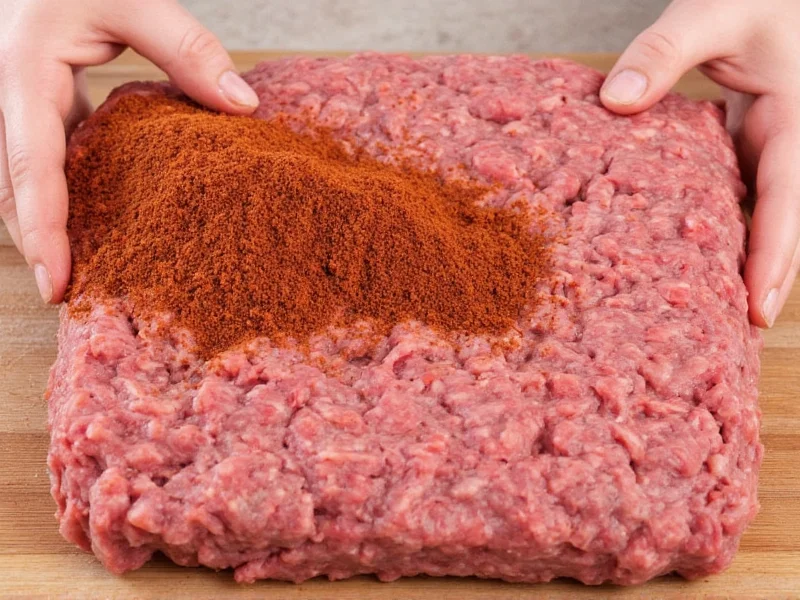Ground beef serves as a versatile canvas for countless dishes, but proper seasoning transforms this humble ingredient from bland to extraordinary. Many home cooks struggle with under-seasoned or unbalanced flavors, often because they add spices at the wrong time or use incorrect proportions. This guide delivers precise measurements and techniques that professional chefs use to maximize flavor in every bite.
Essential Spices for Perfectly Seasoned Ground Beef
The foundation of great ground beef seasoning starts with four core ingredients that work synergistically. Salt enhances natural meat flavors while drawing out moisture that helps spices adhere. Black pepper provides subtle heat and complexity. Garlic powder delivers consistent flavor without burning, unlike fresh garlic. Onion powder offers sweet depth without textural interference. These four elements create a balanced base that complements rather than overwhelms the meat's natural taste.
When measuring spices for ground beef, always use level measurements rather than heaping spoons. Precision matters because ground beef has a relatively neutral flavor profile that easily becomes unbalanced. For every pound of 80/20 ground beef (the ideal fat ratio for flavor and moisture), stick to the foundational ratio of 1 teaspoon salt, ½ teaspoon black pepper, ½ teaspoon garlic powder, and ½ teaspoon onion powder. This proportion prevents overpowering any single flavor while ensuring complete coverage.
Cuisine-Specific Spice Blends
Different dishes require distinct flavor profiles. Understanding these regional variations helps you create authentic-tasting meals without relying on pre-made seasoning packets filled with unnecessary additives. The following table shows professional chef-recommended spice combinations for popular ground beef applications:
| Cuisine Style | Spice Blend (per 1 lb ground beef) | Best For |
|---|---|---|
| Mexican/Taco | 1 tsp chili powder, ½ tsp cumin, ¼ tsp paprika, ¼ tsp oregano, ¼ tsp cayenne (optional) | Tacos, burritos, nachos |
| Italian | 1 tsp dried oregano, ½ tsp basil, ¼ tsp red pepper flakes, 1 tsp tomato paste | Pasta sauces, meatballs, lasagna |
| American Burger | ¼ cup Worcestershire sauce, 1 egg, ¼ cup breadcrumbs, 1 tsp smoked paprika | Burgers, meatloaf, stuffed peppers |
| Asian-Inspired | 2 tbsp soy sauce, 1 tbsp ginger, 1 tsp sesame oil, 1 clove minced garlic | Stir-fries, lettuce wraps, fried rice |
| Mediterranean | 1 tsp sumac, ½ tsp za'atar, ¼ tsp allspice, 1 tbsp lemon zest | Kofta, stuffed vegetables, grain bowls |
Proven Techniques for Flavor Maximization
Timing matters as much as ingredients when seasoning ground beef. Never add salt before browning—this draws out moisture and prevents proper caramelization. Instead, follow this professional sequence: First, cook the ground beef in a preheated skillet over medium-high heat without stirring for 3-4 minutes to develop fond (those delicious browned bits). Break into chunks and continue cooking until no pink remains. Drain excess fat completely, as it carries away spices and creates greasy texture. Return the beef to the pan, reduce heat to medium, then add your spice blend.
Distribute spices evenly by sprinkling them over the beef in multiple stages while gently folding the meat. Add half the spices, fold for 30 seconds, then add the remainder. This technique prevents clumping and ensures uniform flavor distribution. For dried herbs like oregano or thyme, add them early in the cooking process to allow their flavors to bloom. Fresh herbs like cilantro or parsley should go in during the last minute of cooking to preserve their bright flavor.
Always taste before serving—this crucial step separates good cooks from great ones. Remove a small spoonful, let it cool slightly, and assess the seasoning. Need more salt? Add it in small increments (1/8 teaspoon at a time). Too spicy? Balance with a squeeze of fresh lime or a teaspoon of honey. Under-seasoned ground beef often results from adding spices to cold meat or insufficient cooking time after seasoning.
Avoid These Common Seasoning Mistakes
Many home cooks make preventable errors that compromise their ground beef dishes. Adding spices directly to raw meat before cooking causes most spices to burn during browning, creating bitter flavors. Using pre-mixed seasoning packets often introduces excessive sodium and fillers like maltodextrin that dilute flavor quality. Over-seasoning with multiple strong spices creates flavor confusion rather than harmony.
For optimal results, measure spices directly into the pan rather than mixing them in a separate bowl first—this prevents waste and ensures even distribution. When using liquid seasonings like soy sauce or Worcestershire, add them after the spices to prevent steaming the meat. Remember that ground turkey or chicken requires different seasoning approaches due to their milder flavor profiles compared to beef.
Storage and Reuse Tips
Properly seasoned ground beef maintains quality for 3-4 days in the refrigerator when stored in an airtight container. For longer storage, portion cooled beef into 1-cup servings and freeze for up to 3 months. When reheating, add a splash of broth or water to restore moisture, as freezing can dry out the meat. Never refreeze previously frozen seasoned ground beef, as this compromises both texture and food safety.
Leftover seasoned ground beef offers creative second-meal opportunities. Transform taco-seasoned beef into breakfast hash with potatoes and eggs, or fold Italian-seasoned beef into omelets. Mexican-seasoned beef works well as a topping for baked potatoes, while Asian-inspired beef makes excellent fried rice additions. These repurposing strategies reduce food waste while maximizing your cooking efforts.











 浙公网安备
33010002000092号
浙公网安备
33010002000092号 浙B2-20120091-4
浙B2-20120091-4